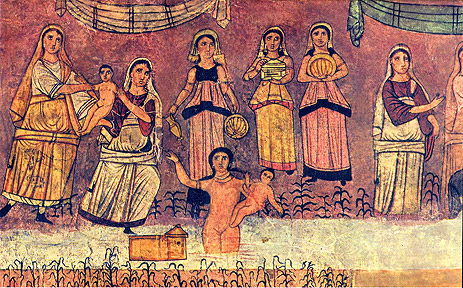Image Resource Bank
Image Gallery |  6 of 15
6 of 15 
Fresco of Moses Taken from the River
In the ruins of the ancient city of Dura-Europos (sometimes spelled Doura-Europos), originally a Greek colony built along the west bank of the Euphrates river in today’s Syria, excavators in the 1930s discovered the virtually intact remains of a Jewish synagogue, built in a private house that had been adjacent to the high city walls and was filled in to resist the Persian siege of 256 CE. It is one of the best-preserved early synagogues yet discovered. The walls of the main prayer room, which included a Torah niche, feature extensive fresco decoration depicting key episodes from the Hebrew Bible (Old Testament). This detail shows the infant Moses being picked from the waters of the Nile by a servant of Pharaoh’s daughter, with various attendants looking on.
In style, the drawings are typical of the Late Antique art of the eastern Mediterranean world, combining the naturalism of Hellenistic and Roman art with some of the features of contemporary Persian art, such as flattening of the figures and the schematic, almost register-like arrangement of figures. These features gradually became more prevalent in early Christian, Byzantine, and Western medieval art.
Name: Moses Taken from the River
Material: Fresco on plaster (detail)
Size: ca. 200 (7 ft 2 in) x 400 cm (13 ft 1.5 in)
Date: 244-255 CE
Place of Origin: 90 meters (295 ft 3.3 in) above right bank of Euphrates, Syria
Location: National Museum, Damascus, Syria
Registration # and Source: Wikimedia Commons. Link to resource![]() (accessed April 27, 2010)
(accessed April 27, 2010)

 Fred M. Donner
Fred M. Donner
Professor of Near Eastern History, University of Chicago




